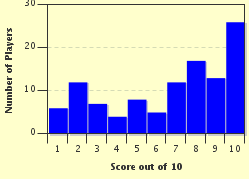Quiz Answer Key and Fun Facts
1. If you have a pair and you fear your opponent has an overpair, a pair of higher rank than yours, then how many outs do you have preflop? (Assume all cards are still in play. Pick the answer that is most accurate.)
2. If you have a flush draw, four cards of the same suit, either on the flop or the turn and the board is not paired, how many outs do you have? (Assume all cards are still in play. Pick the answer that is most accurate.)
3. If you have an open-ended straight draw on either the flop or the turn, there are no more than two of any one suit on the board and the board is not paired, how many outs do you have? (Assume all cards are still in play. Pick the answer that is most accurate.)
4. If you have a gutshot straight draw on either the flop or the turn, there are no more than two of any one suit on the board and the board is not paired, how many outs do you have? (Assume all cards are still in play. Pick the answer that is most accurate.)
5. If you have two overcards against a pair, the pair does not improve on either the flop or the turn, and there are no flush or straight draws available, how many outs do you have? (Assume all cards are still in play. Pick the answer that is most accurate.)
6. If you have only one overcard against a pair, the pair does not improve on either the flop or the turn, and there are no flush or straight draws available, how many outs do you have? (Assume all cards are still in play. Pick the answer that is most accurate.)
7. If you have a flush draw and an open-ended straight draw after the flop and the board is not paired, how many outs do you have? (Assume all cards are still in play. Pick the answer that is most accurate.)
8. If you have a flush draw and a gutshot straight draw after the flop and the board is not paired, how many outs do you have? (Assume all cards are still in play. Pick the answer that is most accurate.)
9. If you have two overcards and a flush draw using both cards in your hand against your opponents unimproved pair, how many outs do you have? (Assume all cards are still in play. Pick the answer that is most accurate.)
10. If you have two overcards, a flush draw using both cards in your hand, and an open-ended straight draw against your opponents unimproved pair, how many outs do you have? (Assume all cards are still in play. Pick the answer that is most accurate.)
Source: Author
tazman6619
This quiz was reviewed by FunTrivia editor
linkan before going online.
Any errors found in FunTrivia content are routinely corrected through our feedback system.

